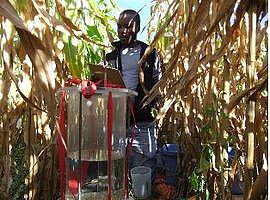Effects of calcium based surface amendments on the hydraulic conductivity and selected physical properties of subsurface drained sodic-saline soils

Anthony W. Wamono is a Ph.D. graduate student in the Agricultural and Biosystems Engineering department at North Dakota State University (NDSU). He holds a Master of Science in Environmental and Conservation Sciences from NDSU and a Bachelor of Science in Agricultural Engineering from Makerere University, Kampala, Uganda. He worked at the Ministry of Water and Environment, Uganda, as a technical officer. His current research is focused on understanding the effects of calcium-based surface amendments on the hydraulic conductivity and selected physical properties of subsurface drained sodic-saline soils. The goal of his work is to develop guidelines for improving drainage, trafficability and workability of saline-sodic soils.
Fellow: Anthony Walekhwa Wamono
Advisors: Dean D. Steele and Zhulu Lin
Effects of calcium based surface amendments on the hydraulic conductivity and selected physical properties of subsurface drained sodic-saline soils
The installation of tile drainage to remove excess moisture in the fall and spring poses a risk of transforming saline-sodic soils to sodic soils in the Northern Great Plains. Yet, leaching of sodic soils with low EC water results in the swelling of the soil, dispersion of clay particles and consequently the breakdown of soil structure. Changes in soil hydraulic and physical properties ensue, such as reduced hydraulic conductivity and increased soil hardness when the soil is dry.
In this study, the cone index (CI), a measure of penetration resistance, will be determined for the plots at Wyndmere and Grand Forks sites in North Dakota using a hand held penetrometer. Soil water content measurements will augment the CI data. Statistical analyses of CI relationships with depth, moisture content, drainage state, and surface treatments will be determined. A Cornell sprinkler infiltrometer will be used to measure the changes in hydraulic conductivity of the plots. The effectiveness of calcium based surface amendments and cover crops under drainage and non-drainage options on improving the hydraulic and mechanical properties soil will be evaluated.
Project Objectives:
The main objective of this study is to evaluate effectiveness of calcium based surface amendments and cover crops under drainage and non-drainage options on improving the hydraulic and mechanical properties of the soil.
Progress:
Penetration resistance
The penetration resistance represented by the cone index was measured for each plot of the 45 plots at Wyndmere and at Grand Forks. A hand held penetrometer was used to take readings at 2.5 cm depth intervals from 0 to 45 cm. A total of ten readings were taken for each plot. In contrast to trafficability, higher CI relates to higher bearing capacity of the soil to support heavy equipment, therefore an increase in the values of penetration resistance for soils treatments indicate improvement of trafficability of the soil. Given that CI is sensitive to moisture content, soil samples from 0-15 cm, 15-30 cm and 30-45 cm depth were taken and gravimetric moisture content was determined. A relation to account for the influence moisture on the CI was pursued.
Infiltration tests A Cornell sprinkle infiltrometer was used to determine the gypsum treatments' effects on the water infiltration properties of a field with tile drainage. Three infiltration tests were carried out on each of three 10 t ac-1 gypsum and check split plots under tile-drained main plots with free outflow. Infiltration rate curves have been developed for these plots. Additionally, key soil hydraulic parameters derived from the infiltration curves will be used as input data for Hydrus 1D modeling. Soil samples for moisture content determination were taken weekly during the corn growing season; these too will serve as key input data for Hydrus 1D modeling.
Significance:
Maintaining productive and sustainable agriculture on poorly drained soils depends on understanding the risk of hard setting posed by draining saline-sodic soils. The results of this study will help develop guidelines and recommendations for removing excess water, thereby improving the trafficability and workability of sodic-saline soils.
Conference/Seminar Presentations:
Wamono, A.W., D.D. Steele Z. Lin, T.M. DeSutter, X. Jia and D. Clay. 2014. Penetration Resistance Measurements to Evaluate the Effects of Calcium Amendments and Water Management Strategies in Sodic-Saline Soils. To be presented at the 2014 ASABE Intersectional Meeting, 28-29 March, Brookings, South Dakota
Wamono, A.W., D.D. Steele Z. Lin, T.M. DeSutter, X. Jia and D. Clay. 2014. Effects of calcium based surface amendments and cover crops on the penetration resistance of subsurface drained sodic-saline soils. To be presented at the 2014 ASABE and CSBE/SCGAB International Meeting, July 13-16, Montreal

Dean D. Steele
Agricultural and Biosystems Engineering
Office: ABE 113
Telephone: 701-231-7268
Email: dean.steele@ndsu.edu

Zhulu Lin
AES Ag & Biosystems Eng
Office: Ag & Bio Eng 104
Telephone: 701-231-7118
Email: zhulu.lin@ndsu.edu


